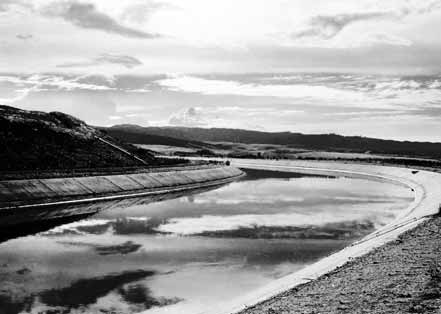|
http://www.capitalpress.info/SiteImages/FileGallery/2531.pdf
Triple threat to ag
Development, restoration, climate issues mount
Mateusz Perkowski
Capital Press
Friday, September 14, 2007
|
 |
|
According to a recent
report by the Family Farm Alliance, more storage
facilities and canals like this one are needed to help
irrigated agriculture overcome pressures from
urbanization, conservation and climate change. - Capital
Press file |
Western farmers now face three major threats to their water
supply, a report from the Family Farm Alliance says.
Not only has irrigated agriculture become a "buffer zone" in
the competition for water between urban development and
environmental restoration but climate change is expected to
diminish snowpacks, the report said.
"Agriculture is being seen as a reservoir," said Dan Keppen,
executive director of the group.
Over the past three decades, water has increasingly been
diverted to satisfy the needs of growing metropolitan areas
or used to boost flow in rivers and streams, but storage
reservoir projects have been at a standstill, he said.
The result: Farmers are left with a shrinking portion of the
pie. If rising temperatures deplete snow packs, reduce
groundwater recharge and boost crop irrigation needs due to
evapotranspiration, the pie itself will contract.
As less water is stored in the snowpack and runs off earlier
in the season, it will be imperative to build more
reservoirs to accrue that supply for use later in the year,
according to the report, "Water Supply in a Changing
Climate."
"You want to be able to capture that water," said Keppen.
Reduced usage will continue to play an important role, but
it cannot be the sole strategy for dealing with climate
change and insufficient water, according to the report.
"It is simply ludicrous to believe that conservation alone
will supply enough water for the tens of millions of new
residents expected to arrive in Western cities during the
coming decades," the report states.
Up until now, the preferred method has been to target
agriculture by leasing or buying out water rights, said
Keppen. However, it's possible to avoid unfairly impacting
this important sector of the U.S. economy and society by
enhancing storage capacity, he said.
So what's the hold up? Layers upon layers of bureaucracy,
Keppen said.
The Bureau of Reclamation has identified 900 possible
reservoir projects across the country, but none have moved
passed the feasibility study stage and actually had shovels
hit the dirt, he said.
"There are many storage sites out there waiting to be
developed," he said.
However, such proposals are typically stalled by seemingly
endless requirements under the National Environmental Policy
Act, the Endangered Species Act, and the Clean Water Act,
Keppen said.
The problem is compounded because projects are often delayed
for long periods of time, he said. So when there's turnover
in the agencies that administer these laws, the applicants
come under fresh scrutiny from new employees, Keppen said.
"The goal line is constantly shifting," he said.
For example, Keppen cites the case of a rancher from Wyoming
who wanted to build a relatively small, 15,000 acre-foot
facility. He did eventually acquire all the necessary
permits and was given permission to build - after 20 years,
Keppen said.
The actual construction took only three months, he said.
"The incredible maze of regulations makes it almost
impossible," Keppen said.
Keppen doesn't advocate overturning or "gutting" these laws
so as to make them ineffectual - but he does want to see
them streamlined so applicants know what to expect from the
process.
"There needs to be a one-stop shop," he said.
Growers, irrigation districts or other entities should be
informed exactly what they will need to do to comply with
requirements - and make those expectations binding for the
agencies involved, Keppen said. That way, applicants feel as
if they're heading toward a goal, rather than running on a
treadmill.
It will also be important to open up federal agencies'
decisions and policies to scientific scrutiny, which would
help prevent environmental laws from being used as political
tools, he said.
"Peer review and the opportunity for local agencies (like
irrigation districts) to have a seat at the table with
federal agencies and biologists would be critical," Keppen
said.
Environmental groups, on the other hand, take a skeptical
view of the Family Farm Alliance's suggestions.
Water storage does have a role to play, but any new
development must be careful not to repeat the mistakes of
the past, which caused environmental degradation, said John
DeVoe, executive director of Water Watch of Oregon.
"We can't simply shave off the top of our hydrograph and
think it has no impact on our rivers and their inhabitants,"
he said.
DeVoe doesn't oppose building new reservoirs, provided they
are properly sited.
"The devil's in the details," he said.
However, he also doesn't believe such projects should take
precedence over conservation - particularly since cities
such as Portland, Ore., and Seattle have shown great strides
in cutting their water consumption.
"We need to evaluate the demand side of the water equation,"
DeVoe said, noting that conservation strategies can offset
the effect of increasing urban populations. "It's a myth
that population growth corresponds with increased demand for
water, at least at the municipal level."
Staff writer Mateusz Perkowski is based in Salem, Ore.
E-mail: mperkowski@capitalpress.com. |

